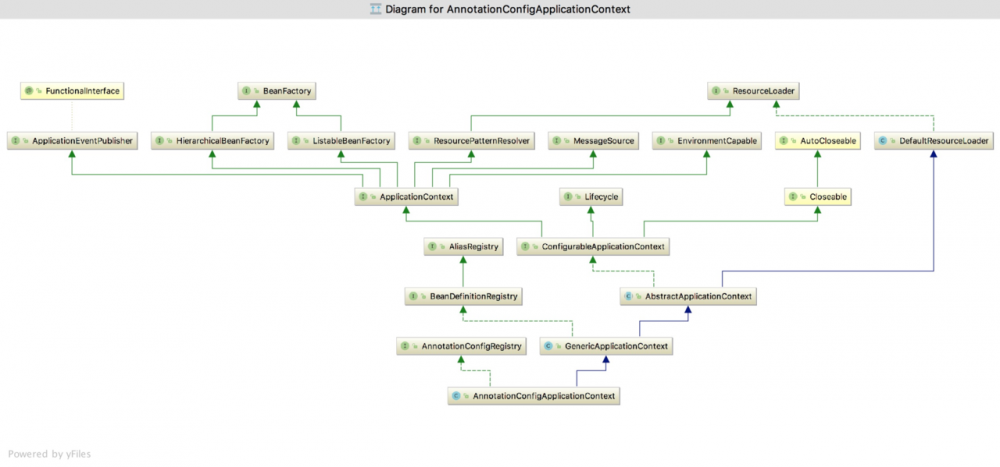Spring IoC 源码分析 (基于注解) 一
IoC 全称为 Inversion of Control,翻译为 “控制反转”,它还有一个别名为 DI(Dependency Injection),即依赖注入。
二、IoC方式
Spring为IoC提供了2种方式,一种是基于xml,另一种是基于注解。
- 标签来定义bean,进行管理。
- @Bean注解来定义bean,进行管理。
本次文章我们就来分析下基于注解的IoC原理,在看文章之前我们可以带一些疑问,这样有助于我们更好的理解。
- @Bean是干什么用的?
- @Controller、@Service又是干啥的?
- @CompoentScan注解是怎么起作用的?
- Spring是怎么发现@Bean、@Controller、@Service这些注解修饰的类的?
- 发现之后是怎么注册到IOC容器中的?
- IOC容器到底是个啥?
三、源码分析
首先看下段代码:
AnnotationConfigApplicationContext aac =
new AnnotationConfigApplicationContext("com.mydemo");
复制代码
AnnotationConfigApplicationContext可以实现基于Java的配置类(包括各种注解)加载Spring的应用上下文。避免使用application.xml进行配置。相比XML配置,更加便捷。
3.1、类结构图

主要类或接口说明:
-
GenericApplicationContext——通用应用上下文,内部持有一个DefaultListableBeanFactory实例,这个类实现了BeanDefinitionRegistry接口,可以在它身上使用任意的bean definition读取器。典型的使用案例是:通过BeanFactoryRegistry接口注册bean definitions,然后调用refresh()方法来初始化那些带有应用上下文语义(org.springframework.context.ApplicationContextAware)的bean,自动探测org.springframework.beans.factory.config.BeanFactoryPostProcessor等。
-
BeanDefinitionRegistry——用于持有像RootBeanDefinition和 ChildBeanDefinition实例的bean definitions的注册表接口。DefaultListableBeanFactory实现了这个接口,因此可以通过相应的方法向beanFactory里面注册bean。GenericApplicationContext内置一个DefaultListableBeanFactory实例,它对这个接口的实现实际上是通过调用这个实例的相应方法实现的。
-
AbstractApplicationContext——ApplicationContext接口的抽象实现,没有强制规定配置的存储类型,仅仅实现了通用的上下文功能。这个实现用到了模板方法设计模式,需要具体的子类来实现其抽象方法。自动通过registerBeanPostProcessors()方法注册BeanFactoryPostProcessor, BeanPostProcessor和ApplicationListener的实例用来探测bean factory里的特殊bean——对比1分析
-
AnnotationConfigRegistry——注解配置注册表。用于注解配置应用上下文的通用接口,拥有一个注册配置类和扫描配置类的方法。
3.2 构造函数
//默认构造函数,初始化一个空容器,容器不包含任何 Bean 信息,需要在稍后通过调用其register()
//方法注册配置类,并调用refresh()方法刷新容器,触发容器对注解Bean的载入、解析和注册过程
public AnnotationConfigApplicationContext() {
this.reader = new AnnotatedBeanDefinitionReader(this);
this.scanner = new ClassPathBeanDefinitionScanner(this);
}
public AnnotationConfigApplicationContext(DefaultListableBeanFactory beanFactory) {
super(beanFactory);
this.reader = new AnnotatedBeanDefinitionReader(this);
this.scanner = new ClassPathBeanDefinitionScanner(this);
}
//最常用的构造函数,通过将涉及到的配置类传递给该构造函数,以实现将相应配置类中的Bean自动注册到容器中
public AnnotationConfigApplicationContext(Class<?>... annotatedClasses) {
//调用无参构造函数,初始化AnnotatedBeanDefinitionReader 和 ClassPathBeanDefinitionScanner
this();
register(annotatedClasses);
refresh();
}
//该构造函数会自动扫描以给定的包及其子包下的所有类,并自动识别所有的Spring Bean,将其注册到容器中
public AnnotationConfigApplicationContext(String... basePackages) {
//初始化ClassPathBeanDefinitionScanner和AnnotatedBeanDefinitionReader
this();//step1
//扫描包、注册bean
scan(basePackages);//step2
refresh();//step3
}
复制代码
主要属性:
-
AnnotatedBeanDefinitionReader——BeanDefinition解析器用来解析带注解的bean
-
ClassPathBeanDefinitionScanner——bean的扫描器 用来扫描类
-
注册解析传入的配置类(使用类配置的方式进行解析)
-
调用容器的refresh方法初始化容器
这里我们用的是最后一种构造函数,即传入一个包路径。
3.3 IoC 之 构造函数初始化
首先看step1,调用了本类的无参构造函数:
public AnnotationConfigApplicationContext() {
this.reader = new AnnotatedBeanDefinitionReader(this);
this.scanner = new ClassPathBeanDefinitionScanner(this);
}
复制代码
然后初始化AnnotatedBeanDefinitionReader和ClassPathBeanDefinitionScanner
我们来看下ClassPathBeanDefinitionScanner的构造函数
public ClassPathBeanDefinitionScanner(BeanDefinitionRegistry registry) {
this(registry, true);
}
复制代码
继续跟踪下去,最后调用的是这个方法:
public ClassPathBeanDefinitionScanner(BeanDefinitionRegistry registry, boolean useDefaultFilters,
Environment environment, @Nullable ResourceLoader resourceLoader) {
Assert.notNull(registry, "BeanDefinitionRegistry must not be null");
//为容器设置加载Bean定义的注册器
this.registry = registry;
//是否使用默认过滤规则
if (useDefaultFilters) {
registerDefaultFilters();
}
//设置环境
setEnvironment(environment);
//为容器设置资源加载器
setResourceLoader(resourceLoader);
}
复制代码
这里面最主要的是registerDefaultFilters()方法,初始化spring扫描默认过滤规则,对应@ComponentScan注解,如果没有自定义规则,就初始化默认过滤规则。
这里调用的是ClassPathScanningCandidateComponentProvider类中的registerDefaultFilters()方法:
//向容器注册过滤规则
@SuppressWarnings("unchecked")
protected void registerDefaultFilters() {
//向要包含的过滤规则中添加@Component注解类
//@Service和@Controller都是Component,因为这些注解都添加了@Component注解
this.includeFilters.add(new AnnotationTypeFilter(Component.class));
//获取当前类的类加载器
ClassLoader cl = ClassPathScanningCandidateComponentProvider.class.getClassLoader();
try {
//向要包含的过滤规则添加JavaEE6的@ManagedBean注解
this.includeFilters.add(new AnnotationTypeFilter(
((Class<? extends Annotation>) ClassUtils.forName("javax.annotation.ManagedBean", cl)), false));
logger.debug("JSR-250 'javax.annotation.ManagedBean' found and supported for component scanning");
}
catch (ClassNotFoundException ex) {
// JSR-250 1.1 API (as included in Java EE 6) not available - simply skip.
}
try {
//向要包含的过滤规则添加@Named注解
this.includeFilters.add(new AnnotationTypeFilter(
((Class<? extends Annotation>) ClassUtils.forName("javax.inject.Named", cl)), false));
logger.debug("JSR-330 'javax.inject.Named' annotation found and supported for component scanning");
}
catch (ClassNotFoundException ex) {
// JSR-330 API not available - simply skip.
}
}
复制代码
这里面有两个关键变量:
-
private final List includeFilters = new LinkedList<>();
-
private final List excludeFilters = new LinkedList<>();
includeFilters表示要包含的注解,即只有包含includeFilters中的注解,才会被扫描
excludeFilters表示要排除的注解,即包含excludeFilters中的注解不会被扫描
在这个方法中,includeFilters集合中添加了@Component、JavaEE6的@ManagedBean和JSR-330的@Named注解
而excludeFilters集合没做任何变动,即没有要排除的注解
总结:
所以默认规则就是,只要包含了@Component、JavaEE6的@ManagedBean和JSR-330的@Named这3个注解中的任意一个,就会被扫描











![[HBLOG]公众号](https://www.liuhaihua.cn/img/qrcode_gzh.jpg)

